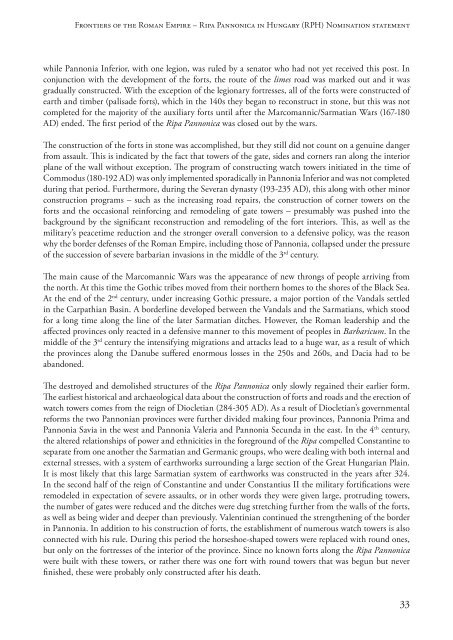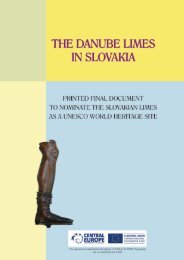the PDF version! - Danube Limes
the PDF version! - Danube Limes
the PDF version! - Danube Limes
Create successful ePaper yourself
Turn your PDF publications into a flip-book with our unique Google optimized e-Paper software.
Frontiers of <strong>the</strong> Roman Empire – Ripa Pannonica in Hungary (RPH) Nomination statement<br />
while Pannonia Inferior, with one legion, was ruled by a senator who had not yet received this post. In<br />
conjunction with <strong>the</strong> development of <strong>the</strong> forts, <strong>the</strong> route of <strong>the</strong> limes road was marked out and it was<br />
gradually constructed. With <strong>the</strong> exception of <strong>the</strong> legionary fortresses, all of <strong>the</strong> forts were constructed of<br />
earth and timber (palisade forts), which in <strong>the</strong> 140s <strong>the</strong>y began to reconstruct in stone, but this was not<br />
completed for <strong>the</strong> majority of <strong>the</strong> auxiliary forts until after <strong>the</strong> Marcomannic/Sarmatian Wars (167-180<br />
AD) ended. The first period of <strong>the</strong> Ripa Pannonica was closed out by <strong>the</strong> wars.<br />
The construction of <strong>the</strong> forts in stone was accomplished, but <strong>the</strong>y still did not count on a genuine danger<br />
from assault. This is indicated by <strong>the</strong> fact that towers of <strong>the</strong> gate, sides and corners ran along <strong>the</strong> interior<br />
plane of <strong>the</strong> wall without exception. The program of constructing watch towers initiated in <strong>the</strong> time of<br />
Commodus (180-192 AD) was only implemented sporadically in Pannonia Inferior and was not completed<br />
during that period. Fur<strong>the</strong>rmore, during <strong>the</strong> Severan dynasty (193-235 AD), this along with o<strong>the</strong>r minor<br />
construction programs – such as <strong>the</strong> increasing road repairs, <strong>the</strong> construction of corner towers on <strong>the</strong><br />
forts and <strong>the</strong> occasional reinforcing and remodeling of gate towers – presumably was pushed into <strong>the</strong><br />
background by <strong>the</strong> significant reconstruction and remodeling of <strong>the</strong> fort interiors. This, as well as <strong>the</strong><br />
military’s peacetime reduction and <strong>the</strong> stronger overall con<strong>version</strong> to a defensive policy, was <strong>the</strong> reason<br />
why <strong>the</strong> border defenses of <strong>the</strong> Roman Empire, including those of Pannonia, collapsed under <strong>the</strong> pressure<br />
of <strong>the</strong> succession of severe barbarian invasions in <strong>the</strong> middle of <strong>the</strong> 3 rd century.<br />
The main cause of <strong>the</strong> Marcomannic Wars was <strong>the</strong> appearance of new throngs of people arriving from<br />
<strong>the</strong> north. At this time <strong>the</strong> Gothic tribes moved from <strong>the</strong>ir nor<strong>the</strong>rn homes to <strong>the</strong> shores of <strong>the</strong> Black Sea.<br />
At <strong>the</strong> end of <strong>the</strong> 2 nd century, under increasing Gothic pressure, a major portion of <strong>the</strong> Vandals settled<br />
in <strong>the</strong> Carpathian Basin. A borderline developed between <strong>the</strong> Vandals and <strong>the</strong> Sarmatians, which stood<br />
for a long time along <strong>the</strong> line of <strong>the</strong> later Sarmatian ditches. However, <strong>the</strong> Roman leadership and <strong>the</strong><br />
affected provinces only reacted in a defensive manner to this movement of peoples in Barbaricum. In <strong>the</strong><br />
middle of <strong>the</strong> 3 rd century <strong>the</strong> intensifying migrations and attacks lead to a huge war, as a result of which<br />
<strong>the</strong> provinces along <strong>the</strong> <strong>Danube</strong> suffered enormous losses in <strong>the</strong> 250s and 260s, and Dacia had to be<br />
abandoned.<br />
The destroyed and demolished structures of <strong>the</strong> Ripa Pannonica only slowly regained <strong>the</strong>ir earlier form.<br />
The earliest historical and archaeological data about <strong>the</strong> construction of forts and roads and <strong>the</strong> erection of<br />
watch towers comes from <strong>the</strong> reign of Diocletian (284-305 AD). As a result of Diocletian’s governmental<br />
reforms <strong>the</strong> two Pannonian provinces were fur<strong>the</strong>r divided making four provinces, Pannonia Prima and<br />
Pannonia Savia in <strong>the</strong> west and Pannonia Valeria and Pannonia Secunda in <strong>the</strong> east. In <strong>the</strong> 4 th century,<br />
<strong>the</strong> altered relationships of power and ethnicities in <strong>the</strong> foreground of <strong>the</strong> Ripa compelled Constantine to<br />
separate from one ano<strong>the</strong>r <strong>the</strong> Sarmatian and Germanic groups, who were dealing with both internal and<br />
external stresses, with a system of earthworks surrounding a large section of <strong>the</strong> Great Hungarian Plain.<br />
It is most likely that this large Sarmatian system of earthworks was constructed in <strong>the</strong> years after 324.<br />
In <strong>the</strong> second half of <strong>the</strong> reign of Constantine and under Constantius II <strong>the</strong> military fortifications were<br />
remodeled in expectation of severe assaults, or in o<strong>the</strong>r words <strong>the</strong>y were given large, protruding towers,<br />
<strong>the</strong> number of gates were reduced and <strong>the</strong> ditches were dug stretching fur<strong>the</strong>r from <strong>the</strong> walls of <strong>the</strong> forts,<br />
as well as being wider and deeper than previously. Valentinian continued <strong>the</strong> streng<strong>the</strong>ning of <strong>the</strong> border<br />
in Pannonia. In addition to his construction of forts, <strong>the</strong> establishment of numerous watch towers is also<br />
connected with his rule. During this period <strong>the</strong> horseshoe-shaped towers were replaced with round ones,<br />
but only on <strong>the</strong> fortresses of <strong>the</strong> interior of <strong>the</strong> province. Since no known forts along <strong>the</strong> Ripa Pannonica<br />
were built with <strong>the</strong>se towers, or ra<strong>the</strong>r <strong>the</strong>re was one fort with round towers that was begun but never<br />
finished, <strong>the</strong>se were probably only constructed after his death.<br />
33











